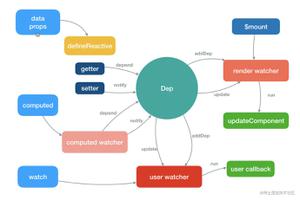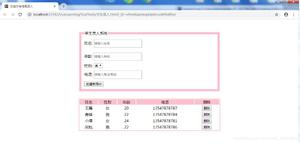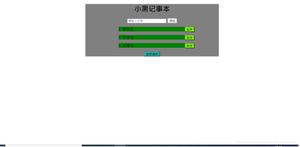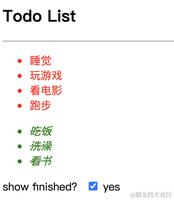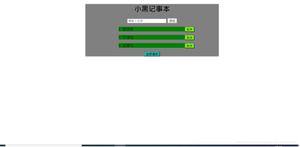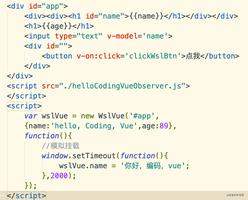vue 学习记录

模板:通常是指html模板
组件component的概念:
在 Vue 里,一个组件本质上是一个拥有预定义选项的一个 Vue 实例,
将组件看作自定义的HTML元素。使用组件的前提是创建并注册组件
vue组件介绍:http://blog.csdn.net/xingjigongsi/article/details/54602404
Vue.js的组件的使用有3个步骤:
1:创建组件构造器------- 调用Vue.extend({template:''})方法创建组件构造器 Vue.extend(html 模板)
2:注册组件------调用Vue.component()方法,注册组件
3:使用组件------------在Vue实例的作用范围内使用组件
例如:
1 <!DOCTYPE html>2 <html>
3 <body>
4 <div id="app">
5 <!-- 3. #app是Vue实例挂载的元素,应该在挂载元素范围内使用组件-->
6 <my-component></my-component>
7 </div>
8 </body>
9 <script src="js/vue.js"></script>
10 <script>
11
12 // 1.创建一个组件构造器
13 var myComponent = Vue.extend({
14 template: '<div>This is my first component!</div>'
15 })
16
17 // 2.注册组件,并指定组件的html标签,组件的HTML标签为<my-component>
18 Vue.component('my-component', myComponent)
19
20 new Vue({
21 el: '#app'
22 });
23
24 </script>
25 </html>
我们用以下几个步骤来理解组件的创建和注册:
1. Vue.extend()是Vue构造器的扩展,调用Vue.extend()创建的是一个组件构造器 (通过html模板来构造一个组件构造器---template)。
2. Vue.extend()构造器有一个选项对象,选项对象的template属性用于定义组件要渲染的HTML。
3. 使用Vue.component()注册组件时,需要提供2个参数,第1个参数时组件的标签,第2个参数是组件构造器。
4. 组件应该挂载到某个Vue实例下,否则它不会生效。
如 id为app的vue实例下
new Vue({ el: '#app'
});
二:注册组件分全局注册和局部注册
调用Vue.component()注册组件时,组件的注册是全局的,这意味着该组件可以在任意Vue示例下使用。
如果不需要全局注册,或者是让组件使用在其它组件内,可以用选项对象的components属性实现局部注册
<script src="js/vue.js"></script><script>
// 1.创建一个组件构造器
var myComponent = Vue.extend({
template: '<div>This is my first component!</div>'
})
new Vue({
el: '#app',
components: {
// 2. 将myComponent组件注册到Vue实例下
'my-component' : myComponent
}
});
</script>
由于my-component组件是注册在#app元素对应的Vue实例下的,所以它不能在其它Vue实例下使用。
三:父组件和子组件
我们可以在组件中定义并使用其他组件,这就构成了父子组件的关系。
1 <!DOCTYPE html>2 <html>
3 <body>
4 <div id="app">
5 <parent-component>
6 </parent-component>
7 </div>
8 </body>
9 <script src="js/vue.js"></script>
10 <script>
11
12 var Child = Vue.extend({
13 template: '<p>This is a child component!</p>'
14 })
15
16 var Parent = Vue.extend({
17 // 在Parent组件内使用<child-component>标签
18 template :'<p>This is a Parent component</p><child-component></child-component>',
19 components: {
20 // 局部注册Child组件,该组件只能在Parent组件内使用
21 'child-component': Child
22 }
23 })
24
25 // 全局注册Parent组件
26 Vue.component('parent-component', Parent)
27
28 new Vue({
29 el: '#app'
30 })
31
32 </script>
33 </html>
我们分几个步骤来理解这段代码:
var Child = Vue.extend(...)定义一了个Child组件构造器var Parent = Vue.extend(...)定义一个Parent组件构造器components: { 'child-component': Child },将Child组件注册到Parent组件,并将Child组件的标签设置为child-component。template :'<p>This is a Parent component</p><child-component></child-component>',在Parent组件内以标签的形式使用Child组件。Vue.component('parent-component', Parent)全局注册Parent组件- 在页面中使用<parent-component>标签渲染Parent组件的内容,同时Child组件的内容也被渲染出来
Child组件是在Parent组件中注册的,它只能在Parent组件中使用,确切地说:子组件只能在父组件的template中使用。
<div id="app"><parent-component>
<child-component></child-component>
</parent-component>
</div> 错误
<div id="app"><parent-component>
</parent-component>
<child-component>
</child-component>
</div> 错误 确切地说:子组件只能在父组件的template中使用。
三:组件注册语法糖
使用Vue.component()直接创建和注册组件
// 全局注册,my-component1是标签名称Vue.component('my-component1',{
template: '<div>This is the first component!</div>'
})
var vm1 = new Vue({
el: '#app1'
})
Vue.component()的第1个参数是标签名称,第2个参数是一个选项对象,使用选项对象的template属性定义组件模板。
使用这种方式,Vue在背后会自动地调用Vue.extend()。
在选项对象的components属性中实现局部注册:
var vm2 = new Vue({ el: '#app2',
components: {
// 局部注册,my-component2是标签名称
'my-component2': {
template: '<div>This is the second component!</div>'
},
// 局部注册,my-component3是标签名称
'my-component3': {
template: '<div>This is the third component!</div>'
}
}
})
四:使用script或template标签
template选项现在不再是HTML元素,而是一个id,Vue.js根据这个id查找对应的元素,然后将这个元素内的HTML作为模板进行编译。
<!DOCTYPE html><html>
<head>
<meta charset="UTF-8">
<title></title>
</head>
<body>
<div id="app">
<my-component></my-component>
</div>
注意:使用<script>标签时,type指定为text/x-template,意在告诉浏览器这不是一段js脚本,浏览器在解析HTML文档时会忽略<script>标签内定义的内容。
<script type="text/x-template" id="myComponent"><div>This is a component!</div>
</script>
<template id="myComponent"><div>This is a component!</div>
</template>
</body>
<script src="js/vue.js"></script>
<script>
Vue.component('my-component',{
template: '#myComponent'
})
new Vue({
el: '#app'
})
</script>
</html>
这使得HTML代码和JavaScript代码是分离的,便于阅读和维护。
另外,在Vue.js中,可创建.vue后缀的文件,在.vue文件中定义组件。
五:组件的el和data选项
传入Vue构造器(即new vue({}))的多数选项也可以用在 Vue.extend() 或Vue.component()中,不过有两个特例: data 和el。
Vue.js规定:在定义组件的选项时,data和el选项必须使用函数。
Vue.component('my-component', { data: {
a: 1
}
}) 报错,在定义组件的选项时,data和el选项必须使用函数。
另外,如果data选项指向某个对象,这意味着所有的组件实例共用一个data。
我们应当使用一个函数作为 data 选项,让这个函数返回一个新对象:
Vue.component('my-component', { data: function(){
return {a : 1}
}
})
六:使用props
组件实例的作用域是孤立的。这意味着不能并且不应该在子组件的模板内直接引用父组件的数据。可以使用 props 把数据传给子组件。
组件的props选项,它用于将父组件的数据传递给子组件,prop 是父组件用来传递数据的一个自定义属性
注意:在子组件中定义prop时,使用了camelCase命名法。由于HTML特性不区分大小写,camelCase的prop用于特性时,需要转为 kebab-case(短横线隔开)。例如,在prop中定义的myName,在用作特性时需要转换为my-name。
js中用驼峰式写法,html中因为不区分大小写,需要用短线-隔开。
var vm = new Vue({ el: '#app',
data: {
name: 'keepfool',
age: 28
},
components: {
'my-component': {
template: '#myComponent',
props: ['myName', 'myAge']
}
}
})
为了便于理解,你可以将这个Vue实例看作my-component的父组件。
如果我们想使父组件的数据,则必须先在子组件中定义props属性,也就是props: ['myName', 'myAge']这行代码。
定义子组件的HTML模板:
<template id="myComponent">
<table>
<tr>
<th colspan="2">
子组件数据
</th>
</tr>
<tr>
<td>my name</td>
<td>{{ myName }}</td>
</tr>
<tr>
<td>my age</td>
<td>{{ myAge }}</td>
</tr>
</table>
</template>
将父组件数据通过已定义好的props属性传递给子组件:
<div id="app">
<my-component v-bind:my-name="name" v-bind:my-age="age"></my-component>
</div>
prop的绑定类型
单向绑定
组件模板:是带有组件的html模板
总结:
Vue.component用来注册组件,第一个参数是组件名称,第二个参数是组成组件的对象,即html模板template
new Vue中的components参数可以局部注册多个组件,{Vue.component1, Vue.component2,...}
以上是 vue 学习记录 的全部内容, 来源链接: utcz.com/z/378147.html

